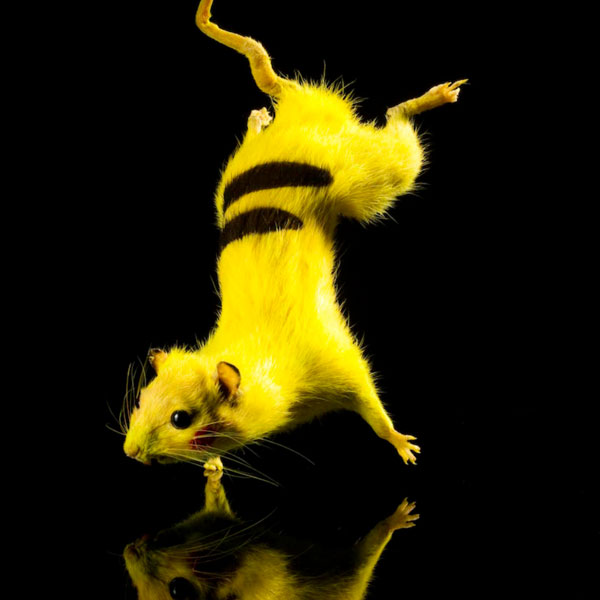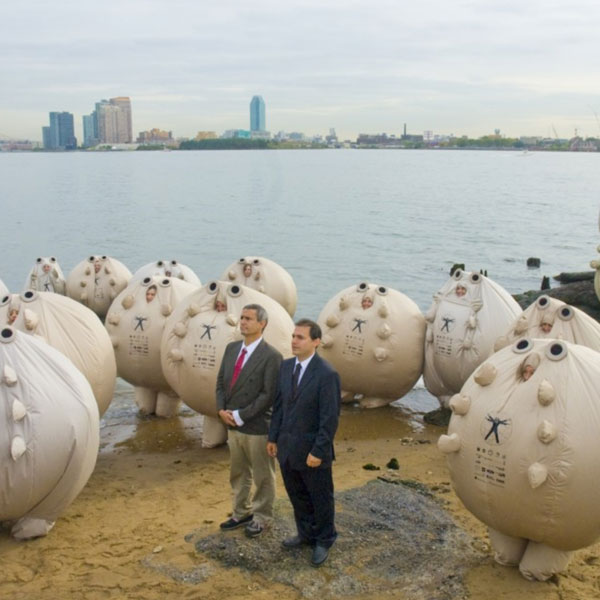
Today we’re redirecting your gaze, shifting it away from the individual artist to explore that of the Collective instead.
What are the purported benefits of being in a collective? Is there freedom enabled by working together? A blending of interdisciplinary fields, ideas, skills, and opinions allowing room for greater statements to be made. A combination of powers, and funding to tackle larger projects, previously unattainable alone. Perhaps a certain safety in numbers, where no one person is held singularly responsible.
After using our artist ranking system to search for Art groups with a ranking of 3000 or under, here are four collectives that caught our attention for one or more of the above reasons,

Los Carpinteros, Cuba
Meet the trio behind Los Carpinteros; Formed in 1992 by Marco Antonio Castillo Valdes and Dagoberto Rodriguez Sanchez and Alexandre Arrechea (though Arrechea left the trio behind in 2003). The group was established as a rejection of the individual artist, favouring instead an older tradition of artisans and labourers. The combination of their skills and gently humorous political commentary has resulted in an oeuvre of outstanding work, including pieces considered to be some of the most important to come from Latin America in a decade. Check out “The Meeting Room” to get a taste of what they can do.
Chim↑Pom, Japan
Chim↑Pom is an artist collective formed in 2005 in Tokyo with members; Ryuta Ushiro, Yasutaka Hayashi, Ellie, Masataka Okada, Motomu Inaoka, and Toshinori Mizuno. With pieces ranging from stuffed and painted “Super Rats” in the form of Pikachu’s commenting on an explosion of urbanisation and living amongst radioactive contamination to commenting on previous pandemics class injustice’s; Just last year with an unknown foreshadowing, they released their piece, “A Drunk Pandemic” in which they opened a brewery under the Manchester Victoria station where tens of thousands of mostly lower-class cholera victims are buried, Beer being preferred to water for sanitary reasons at the time.
It’s impossible not to draw alarmingly similar parallels to the way our current pandemic is disproportionately impacting lower socioeconomic demographics. The power of working together allows the group the opportunity to “intervene in contemporary society with strong social messages.” on the grand scale.
The Propeller Group, Vietnam
The The Vietnam based art collective, The Propeller Group, was founded by Tuan Andrew Nguyen, Phunam Thuc Ha, and Matt Lucero.
The collective found a way of smartly tip-toeing around the political restrictions of living in a one-party communist state, to deliver quietly poignant creative offerings. (Any of which were produced or released in Vietnam, having to be approved by a government agency.) From a tongue-in-cheek rebranding “Television commercial for Communism” to commissioning the artists from Dafen, (where most of the world’s reproductions of oil paintings are produced) to finally use artistic freedom to paint themselves with the classics they reproduce. Aside from these self-portraits being incredibly moving, the concept is an example of the flexibility permitted by being in a collective, and how that freedom of collaborating can be used to reach a broader audience. The group has now disbanded, but wish to keep the name active and in doing so, have highlighted another possible positive of working under a group title: “What if the collective simply carried on with new members?”
The Yes Men, USA
And last but not least, we bring you The Yes men, a group founded by two tricksters Andy Bichlbaum and Mike Bonanno (apparently not their real names) essentially just to “stick it to the man”. What started as a duo of like-minded-frustrated friends creating political stunts-come-comical performance art, has grown into a mass movement of inspired prankster-activists collaborations with organisations and a network of supporters. From infiltrating conferences, or producing fake newspapers, to being interviewed on live television as (unbeknownst to the reporters) faux representatives of massive corporations. The lines between art and activism are so blurred with The Yes Men that it’s hard to see where one begins and the other ends, and is exactly why they are so successful.
It seems that belonging to an artist collective can indeed enable broader freedom. Whether that is achieving a new level of work when combining interdisciplinary skills, finding courage (and funding) to approach larger projects, or to have the (assumed) safety in numbers to openly tackle anything from unjust social structures to communist regimes.
Perhaps more than anything though, the biggest benefit of all, is simply not facing it alone. The weight of the world isn’t nearly so heavy when it is shared.




